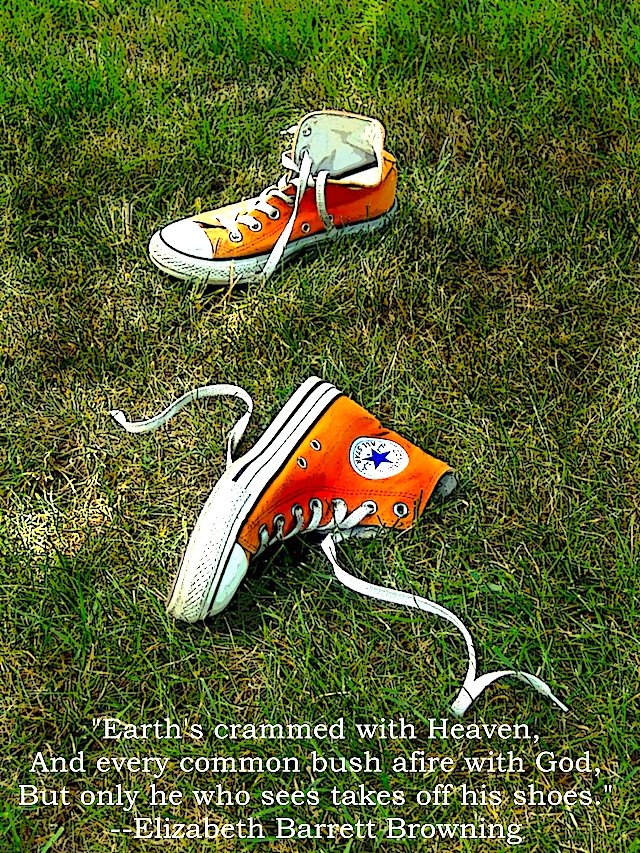Afire.
art by Sarah Hornsby
Part 3 of 3, a series on Pilgrimage.
After a while we get used to it and quit noticing. We get narrowed down into something small and constricting. Somewhere along the way this exponential expansion of awareness, this wide-eyed looking around, this sheer untaught delight in what is here reverses itself: the world contracts; we are reduced to a life of routine through which we sleepwalk.
~ Eugene Peterson
Two years ago I wrote a post that referenced the idea of “thin places”—geographical locations that seem to carry a uniquely sacred sense about them that endures over time and is experienced by many different people. Places like these often become destinations for pilgrimage. I admit that this was part of our incentive to visit Iona this summer, and I had probably romanticized it somewhat in my mind. What would it feel like to walk and worship where countless other pilgrims had done so for the last 15 centuries?
Bottom line: I loved Iona… but I didn’t feel closer to God there than anywhere else. I have felt a sacred quality in specific places before, so why not here? And if we walk the Camino de Santiago (which we hope to do next summer), will we feel it there? For those who love the experiential presence of God (which I do), is this even a legitimate quest?
Here’s how I’m thinking about it post-Iona: I wonder if almost anywhere could be “thin” if we simply paid attention, if we were actually looking for the divine tapestry woven into creation all around us. Could we carry “thinness” into our homes, into our workplaces, out on a hike, or into our gatherings with friends—just by paying attention? I think so.
I’m not saying that there aren’t thin places per se. I think it’s possible. But I also believe it is the very act of looking for God’s fingerprints and expecting divine encounter that makes them “thin.” Which I find very encouraging! Even in that post two years ago, I wrote this: (Jesus) invited his listeners to inhabit the Thin Place in all places and mediate the Thin Place to all people. I suspect that the human quest could even be defined in these terms and that the lack of this realmic interpenetration is the source of all human weariness.
If we can invite spaces into “thinness” by virtue of our sacred attention, it’s equally true that we can cast spaces in “thickness,” at least experientially speaking, by virtue of our distraction, preoccupation, and inattention… just as Peterson warns us about in the epigraph. But he continues that thought with a surge of promise. “…But not for long. Something always shows up to jar us awake: a child’s question, a fox’s sleek beauty, a sharp pain, a pastor’s sermon, a fresh metaphor, an artist’s vision, a slap in the face, scent from a crushed violet. We are again awake, alert, in wonder: how did this happen?”
And this, I believe, is the true invitation of pilgrimage. I genuinely hope you will step foot outside your door, journey to a foreign land, and encounter God in a place of geographical spiritual gravitas. But more than that, I hope you will step foot outside your door and bring thinness with every single footstep you take… because you carry spiritual vision. You see past the obvious to the noumenal. You see the bush ablaze. Because you’re paying attention. That’s what makes you a pilgrim and not a tourist.
Two weeks ago I introduced you to the word “coddiwomple.” Here’s another: peregrinatio. Peregrinatio means leaving one's homeland and wandering for the love of God. Again, there is both a literal and a mystical sense of this vision for our lives. Maybe you need to put a pack on your back, pick up a walking stick, and go wander physically for a while. I recommend it. Or perhaps you need to jar yourself out of a life on auto-pilot, start recognizing all the bushes afire with God, and take off your shoes.
growing the soul
What will you do to wander and wonder today?
serving the world
How will your pilgrim spirit benefit the world around you?
takeaway
Step outside.


